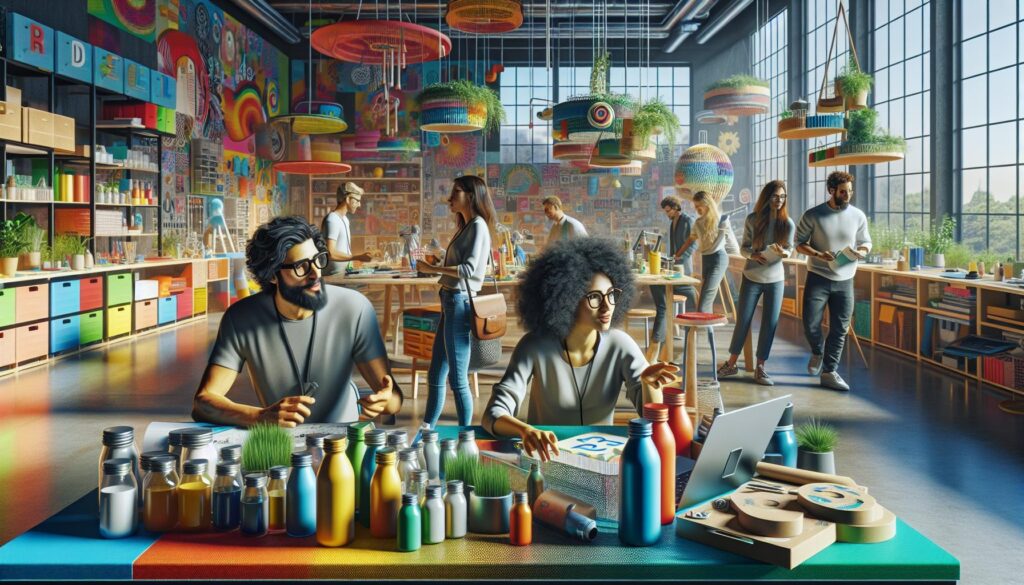Art has been a copy of nature, recording its beauty and carrying it on to paint. Since the inception of the first cave paintings, man has endeavored to describe the world, driven by the green hills, the great forests, and the ever-changing sky. Nature and art’s association has been in existence for centuries, as the painter uses the brush to convey the emotions produced by the outdoors.
Nature’s role in art extends beyond its aesthetics. Nature incites an emotional response from the observer towards the environment, calling to mind peace, nostalgia, or wonder. Artists depict nature with realism, and others illustrate it abstractly, using color and texture to create interpretations rather than direct representation. This article explains how artists are able to personify nature, the emotional appeal of such works, and the impact nature-inspired painting has on contemporary spaces.
Methods for Depicting the Beauty of Nature
Painting nature is a skill, as much as an art. The balance of light and dark, movement and texture has to be handled professionally. There are artists who try photographic realism, reproducing painstakingly every detail, while there are others who try to bring to the foreground the energy of nature. This skill takes training in artistic methods that increase realism and emotional potential of the subject.
Use of Light and Shadow
- Natural light is a critical component of nature painting, creating mood and depth.
- Chiaroscuro techniques such as the use of contrast create a sense of realism and drama.
- Atmospheric perspective, in which distant objects are lighter and less distinct, aid in the creation of depth in a painting.
- Artists who are aware of the outdoor light conditions compose plein air paintings in order to record the direct impact of sunlight on outdoor landscapes. The light intensity, temperature, and angle change so drastically during a day and must be depicted realistically by artists.
- Golden hour, the short period of time after sunrise or before sunset, produces diffused light that artists attempt to replicate. Lighting shadow and color softly, nature is then more dramatic and appealing.
Texture and Movement in Nature
- Impasto techniques, with thick paint applied using palette knives or brushes, replicate the rough texture of tree bark or churning waves in the ocean.
- Smooth, blended brushstrokes are used to show smooth water reflections or soft horizons of far-off hills.
- Quick, forceful brushstrokes suggest movement, such as wind in leaves or a rush in a river.
- Painters also frequently use dry brushing to achieve textured effects such as rough terrain, i.e., rocky terrain or fields.
- Thin, transparent washes of paint can be used to imply movement by subtly modulating tone and merging colors together in a gradual blend.
- Other artists try out unusual tools such as rags or sponges to deliver paint and form organic, irregular textures more reminiscent of natural forms.
Color Theory in Landscape Painting
- Complementary color schemes provide depth, with leaves and skies appearing rich.
- Gradated natural pigments are painted in order to reduce transitions between objects.
- The emotional effect of color influences the response of the eye to nature—warm earth tones and cool blues are soothing.
- Season influences color palettes to an extreme degree. Spring landscapes have bright greens and pale flowers, and fall landscapes highlight oranges and reds.
- Practically every artist except the simplest reduces the range of colors used to harmonize colors in a painting in order to render natural forms more realistic and consistent.

Original Oil Paintings and Their Depth
- There is no equal to original oil painting for richness and depth of layering in fine graduations of tone and texture.
- Glazing, in which thin transparent layers are superimposed, gives luminosity to water and sky.
- Blending with slow-drying oils creates soft edges that replicate natural light-to-dark gradations.
- Most artists use oil paints for landscapes as they can be used to achieve subtle and bold textures as well.
- A few other artists prepare their own natural pigments to represent nature’s realism, using earth tones to replicate the environment.
The Symbolic and Emotional Strength of Nature in Painting
Nature in painting is not merely a physical representation of water, mountains, and trees. It symbolizes the inner emotions, symbolism, and human connection with nature. Artists have attributed meaning to natural objects so that humans can connect with paintings on a higher level.
Symbolism in Natural Elements
- Trees are typically symbolic of growth, strength, and change.
- Rivers and oceans symbolize movement, passage of time, and depth of emotion.
- Flowers are very versatile and may have any degree of varied meanings—love for roses, innocence for lilies, strength for sunflowers.
- The sky in a painting may also symbolize freedom, spirituality, or risk of change, depending on its depiction.
- Animals have been used by artists for centuries as symbols of human emotion or society ills, i.e., birds of peace or wolves of liberty.
Emotional Response to Nature
- Sunshine meadow or dark forest scenes move one to feelings of calm and peaceful contemplation.
- Storms or turbulent seas find outlet for inner turmoil and lusty passion.
- Romantic landscape can bring to mind a recollection of youthful years or favourite haunts.
- Some paintings create a powerful feeling of communion with the viewer, particularly when artists portray scenes that recall isolation, awe, or contemplation.
- The human figure is typically set in expansive, intimidating natural environments to highlight themes of insignificance, self-reflection, or the sublime.
Cultural Perspectives on Nature in Art
- Classical Chinese ink paintings highlight the harmony between humans and nature, and rivers and misty mountains are common subjects.
- Aboriginal painting employs nature as a narrative aid to depict spiritual goals and to locate sacred.
- Landscape was employed as a discourse medium for the discussion of human feeling by the Romantic European painter, and dramatic skies with intense scenery created powerful mood induction.
- Japanese artists often employ the subject of the cherry blossom as fleeting beauty and the transience of life.
- The Scandinavian artist records the climatic loneliness of the northern landscape and is typically occupied with isolation and survival.
The Influence of Nature-Inspired Art in Contemporary Spaces
Nature-inspired art is more than traditional paintings. It is also a focal point of contemporary interior design, public art, and nature-inspired environmental art movements.From large-scale murals and environmental artworks to the incorporation of natural elements in home settings, nature continues to influence art.
Nature-Inspired Art in Interior Design
- Natural landscape paintings on walls provide indoor settings with a sense of calmness and harmony.
- Engaging in paint by numbers for mindfulness can also be a way to bring these nature-inspired designs into a space while promoting relaxation and focus.
- Abstracted pieces of nature provide a modern, minimalist aesthetic.
- Textured mixed-media pieces provide dimension, replicating natural textures like stone, bark, or water.
- Botanical painting and art have gained popularity in domestic design during recent times, offering an everlasting aesthetic that complements most furnishings.
- Muted, earth-toned color schemes in art supply a grounding vibration to living spaces.

Sustainability and Eco-Friendly Art
- Artists increasingly are employing natural pigments derived from plants and minerals.
- Materials recovered, such as recycled metal and reclaimed wood, contribute to sustainability in art.
- Biodegradable art, such as temporary street installations, embraces the ephemeral nature of natural beauty.
- Participatory art, such as nature-integrated art where nature is incorporated in the art, such as sculptures made of moss or sun-sensitive paintings that change with exposure to sunlight.
Public Art and Urban Spaces
- Cityscapes are decorated with nature and greenery incorporated into spaces created by mankind.
- Sculpture outside interacts with the environment, being affected by weather and light.
- Public community art projects make it possible for public interaction with nature in the shape of extensive public works.
- Urban planners include living walls and plant installations within city planning, marrying architecture and nature.
Conclusion
Art is a way to fill in the space between human emotion and nature, finding nature’s beauty that can best be mimicked by photography and literature. With the use of early oil paintings, huge murals, or eco-friendly techniques, artists continue to find ways to reflect the world of nature in startling clarity. Nature-inspired art adorns homes, heals emotionally, and brings about an awareness of environmentalism.”. Once the artists master their craft and get new media, the relationship between nature and art is no less intense, compelling the viewer to see the world as the artist sees it.



